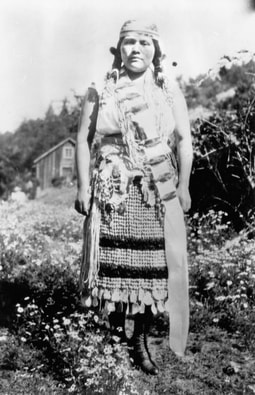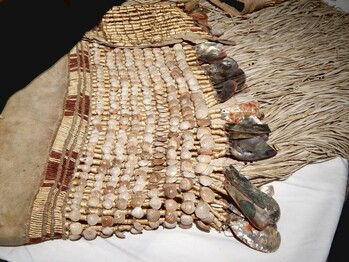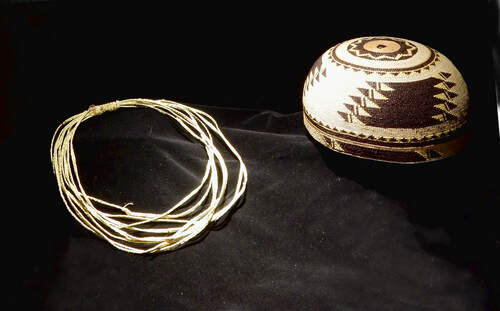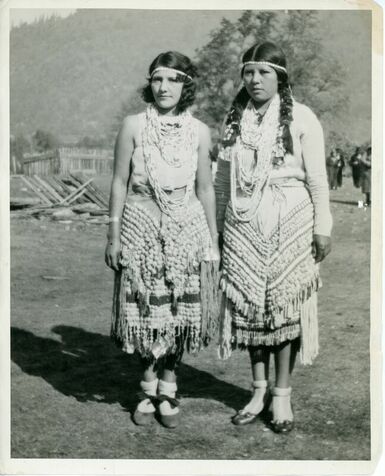Old Ways of Making:
 Unknown native american woman, date unknown. wearing skirt and apron, sash, necklaces, hair wraps and cap. 2005.063.623
Unknown native american woman, date unknown. wearing skirt and apron, sash, necklaces, hair wraps and cap. 2005.063.623
The dresses that were made pre-contact were made with deer hide such as this skirt and apron worn in the photograph shown above, as well as the dress from the Becker collection on display (1987. 32. 6-7). Here the form of the dress skirt is made by folding a deer hide in half, leaving a gap for the ties, and using the top fold as the decorative space. From there the top fold of the hide is then stripped into lengths of fringe.
The dresses that were made pre-contact were made with deer hide such as this skirt and apron worn in the photograph shown above, as well as the dress from the Becker collection on display (1987. 32. 6-7). Here the form of the dress skirt is made by folding a deer hide in half, leaving a gap for the ties, and using the top fold as the decorative space. From there the top fold of the hide is then stripped into lengths of fringe.
 Skirt from Becker Collection, unknown maker, late 1800's. 1987.32.6
Skirt from Becker Collection, unknown maker, late 1800's. 1987.32.6
Here specifically, the lengths are gathered into bundles and wrapped with Beargrass, and alternating with clamshells to make a netting-like structure that looks like a solid form. Aprons from this time vary between leather stripped down with intensive Beargrass wrapping, multiple styles of Beargrass braids (apron, lizard tail, etc.) and use of pine nuts, juniper berries, and small abalone chips or beads. In some dresses from this time period you will notice use of seemingly random materials sneaking in. Small numbers of deer dew claws used in a dress, small metal bells, a bone threaded amongst juniper berries, glass trade beads thrown in the mix.
There is an old adage locally that is “You use what you have”, and the idea being that anything that was beautiful, sounded good, or was valuable goes into the making of the dress. In some cases you will see dentalium necklaces mixed with metal coinage – showing this duality of value but also imparting a wonderful sound.
There is an old adage locally that is “You use what you have”, and the idea being that anything that was beautiful, sounded good, or was valuable goes into the making of the dress. In some cases you will see dentalium necklaces mixed with metal coinage – showing this duality of value but also imparting a wonderful sound.
|
Besides the dress itself, other accessories varied depending on the ceremony or occasion. Here are two examples of other regalia that are worn with the dresses.
The Halo would be worn over the girls’ head, like these clamshell headbands in the photograph to the left taken during the Jump Dance ceremony, seen here in Hoopa Ca. during the 1930’s. The maker would have gathered porcupine quills then would dye it to be this brilliant yellow using wolf moss (Letharia Vulpina), then braided over the iris fiber twine (Iris Macrosiphon). These eight strands that make up this halo are labor intensive and fine work. Ceremonial caps are generally worn during the Brush Dance, often seen as a healing ceremony for a sick child; the girls would wear their cap, hair wraps, necklaces and their dress. Today caps are worn for ceremonies, but also for different important life events such as weddings, graduation ceremonies and more. |

Left to Right:
Porcupine Quill Halo, Unknown maker, c. 1900. braided porcupine quills dyed with wolf moss, iris twine, Clarke Collection.
Ceremonial Cap, woven by Carrie Roberts (Yurok), c. 1900, willow sticks, spruce root, beargrass, maidenhair fern, & porcupine quill dyed with wolf moss. Flint deesign with secondary quill motif. Becker Collection.

